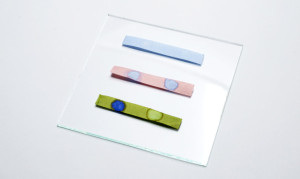
Catherine Klapperich’s lab creates point-of-care diagnostics—tools, such as a pregnancy test stick, that doctors and regular people can use to immediately test for conditions like high cholesterol or diagnose illnesses like strep throat.
One critical need in the developing world is a rapid test for HIV viral load—the amount of HIV in a patient’s blood. The number helps doctors monitor the disease, decide when to start treatment, and determine if HIV medications are working.
Boston University writer Barbara Moran recently spoke to Klapperich, associate professor in the College of Engineering’s biomedical engineering and mechanical engineering departments and the division of materials science and engineering, about her work.
A LOT OF YOUR WORK FOCUSES ON PUBLIC HEALTH ISSUES. WHERE DOES THAT INTEREST COME FROM?
When I got my PhD at Berkeley, I was studying artificial hips and knees. They have a metal part and a plastic part, and we were engineering the plastic part. I became interested in how cells interact with biomaterial surfaces. And that led into my postdoc, which focused on how cells interact with biomaterials at the level of gene expression.
At that time, gene chips were just becoming a routine tool in the laboratory. And I was completely floored by all the steps to use them: breaking the cells open, getting the DNA or RNA out, amplifying it, putting it on a chip, and then turning on the reader to figure out the expression levels. It was a huge number of steps. As an engineer I thought, why? So I became really interested in doing this stuff in a turn-crank way, where I wouldn’t have to do all the little steps.
A MACHINE WOULD DO IT INSTEAD?
The machine would do it. The gene chip is a wondrous thing. And yet it took two and a half days to make the material to go onto that chip. So I became very focused on the sample preparation process. Then it became clear to me that this is why point-of-care diagnostics do not exist in the numbers that they should. Because yeah, we have this chip and it can tell us all this information, but all this prep requires someone with a lot of laboratory skill.
SO YOU WANT TO TAKE THE DIAGNOSTIC CHIP, HAVE SOME PATIENT SPIT ON IT, AND THEN HAVE THE ANSWER SHOW UP WITHOUT TWO AND A HALF DAYS OF SAMPLE PREP?
Right. And so for DNA and RNA it’s hard, because most of it is inside of our cells or inside the bugs that infect us. So you have to break cells apart and amplify the DNA or RNA—make many, many copies. Then you tag them with something like a fluorescent protein that allows you to see them.
So we need to do three things: we need to extract, we need to amplify, we need to read. Let’s do those three things as simply as we can, in as few steps as we can, as reliably as we can. We want to be the test kitchen for this work.
THIS FIELD HAS GROWN A LOT, EVEN IN THE LAST 10 YEARS.
Yeah—now you can walk into Walgreens and there’s a little blue sign hanging over the aisle, where it says things like Foot Powder and Toothpaste, and it says Diagnostics. And I remember the first time I saw that a few years ago. I thought, what? That’s crazy! This is now a thing in the aisle.
IT’S A NOUN.
Exactly. There are the glucose strips, there’s a cholesterol test. You can buy a drug test—
A DRUG TEST FOR WHAT?
For your kid. This is the marijuana one.
REALLY? THIS BOX YOU’RE SHOWING ME IS A MARIJUANA TEST KIT?
Yeah. This is great. You can buy the 4-drug test, the 7-drug test, or the 12-drug test. You can test your kid for depressants, barbiturates, methadone, benzodiazepines, opiates, ecstasy, amphetamines, methamphetamines, cocaine, marijuana, and Oxy. It’s pretty amazing. And it’s just pee.
I think it really empowers people to have information about their own health. If you think about cholesterol tests, and HIV yes/no, respiratory infections, strep, these things can be done by the patient. That can save an office visit, which saves money; it saves the potential of infecting other people; it saves the time of the clinician. I think it will change the primary care model a lot.
WHAT’S THE FIRST THING OUT OF YOUR LAB THAT MIGHT MAKE IT INTO WALGREENS?
It’s an HIV viral load test that we’re working on with a company in San Francisco.
A colleague told me last week, from his clinic in South Africa, “We need a viral load test. If people come to see me and I tell them, ‘I’m going to take your blood, come back to get the results,’ 50 percent of them just don’t come back. Something that would help tomorrow is if I could give that person their results right there. And if their viral load is suppressed, then I don’t have to expend any resources seeing that person until the following year.”
They’re testing that right now in South Africa. That could be deployed in a primary care clinician’s office, and that’s the first thing that will come from our laboratory.
THAT WILL BE COOL.
Yeah, it will be very cool.
Source: Boston University and Futurity.org








